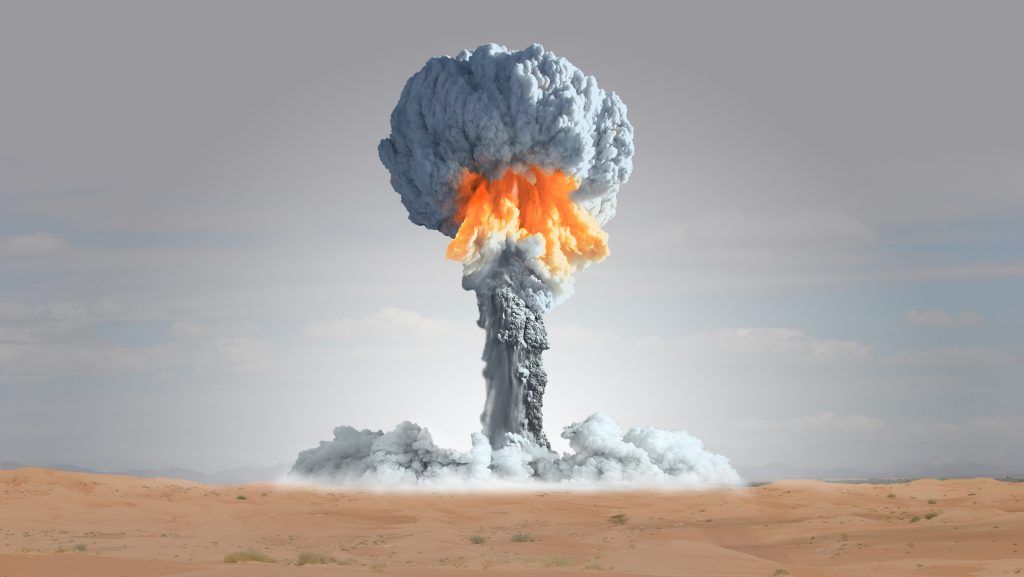Measuring radiation doses in mass-casualty emergencies
By Mary Sproull, Kevin Camphausen, Gregory D. Koblentz | October 4, 2017

For the first time since 1981, when China deployed the DF-5 intercontinental ballistic missile, a new state has gained the capability to target the United States with a nuclear weapon. On July 4 and again on July 28, North Korea launched the Hwasong-14—a two-stage, liquid-fueled ballistic missile that demonstrated the capability to reach the continental United States. The US intelligence community assesses that North Korea has nuclear warheads compact and light enough to fit on the Hwasong-14 and that North Korea will be able to deploy a nuclear-armed intercontinental ballistic missile within one or two years. North Korea demonstrated another new capability on September 3, testing what it claimed was a thermonuclear weapon. While the exact configuration of this “advanced nuclear device” remains unknown, the device’s estimated yield is 140 kilotons, so the test represents a quantum leap in the destructive potential of North Korea’s nuclear arsenal.
Tensions between the United States and North Korea escalated dramatically in the wake of these missile and nuclear tests. Donald Trump and Kim Jong-un engaged in a frightening war of words. The tensions prompted Hawaii, Guam, and California to increase their preparedness for a possible nuclear strike.
The medical consequences of even a single nuclear detonation would be horrific. According to Jerome Hauer, former director of emergency management for New York City, no city in the United States is prepared for the casualties, chaos, and destruction that would follow a nuclear detonation. Medical management in particular would be complicated by damage to infrastructure and communication systems, lack of sufficient first responders, scarce resources, complicated triage needs, and an overwhelming number of patients.
But Hauer highlights another set of crucial challenges—those associated with the diagnosis and treatment of radiation-related injuries:
Beyond the difficult front lines of triage, survivors of a nuclear explosion will have a variety of injuries, some well known to modern hospitals but others more difficult to diagnose and develop a plan for. Acute radiation syndrome, in particular, results from exposure to radiation and does not have to coincide with any other injury. It may be the only effect a survivor suffers, and it may not manifest soon after exposure.
Fortunately, new types of diagnostics to address this critical need are being developed in the field of radiation biodosimetry. Radiation biodosimetry is the estimation, through observation of biological variables, of received dose from previous radiation exposure; the new diagnostics use changes in various biological markers to estimate the severity of radiation doses. Progress in radiation biodosimetry science is beginning to translate into advanced, field-deployable technologies. The United States could significantly improve its preparedness for a radiological or nuclear disaster if, while better leveraging its existing capability for biological dosimetry assessments, it also integrated emerging technologies into its radiological emergency planning and response.
Although federal guidelines for radiological emergency planning and response highlight the importance of radiation dose assessment as a core need for medical management of mass radiation exposures, the ability to rapidly and reliably measure radiation exposure in large numbers of victims is extremely limited in the United States. A 2010 review of US preparedness for a large-scale radiological event found that the United States lacked a number of key capabilities required to implement that mission, including:
- executable interagency procedures for medical triage following a radiological event
- adequate biodosimetry laboratory capacity
- a strategic plan to activate surge capacity resources for biodosimetry capability
- operational guidelines for biodosimetry sample handling and reporting
- requirements for short-term and long-term monitoring of individuals exposed to radiation
- establishment and integration of emerging high-capacity biodosimetry technologies
These capabilities would be useful for responding to the detonation of a nuclear weapon, to a “dirty bomb” attack with radioactive material, or to an accident at a nuclear power plant such as the one that occurred at Japan’s Fukushima Daichii facility in 2011. In particular, enhancing preparedness for a radiological emergency requires immediate attention in three areas: establishing a surge capacity for biodosimetry labs; developing new biodosimetry assays; and integrating biodosimetry into operational response plans.
Surge capacity. In the United States, limited laboratory and point-of-care diagnostics are available to determine if someone has been exposed to radiation and, if so, to what degree. Moreover, currently available tools are poorly suited for management of a mass-screening scenario. The only point-of-care capabilities now available for biodosimetry assessment are lymphocyte depletion kinetics (measuring the rate of depletion of white blood cells to estimate received radiation dose) and clinical evaluation. Lymphocyte depletion kinetics is not conducive to triage biodosimetry because a baseline sample is needed soon after exposure for comparison with samples collected later at predetermined points in time. Clinical evaluation for dose assessment, such as time to onset of vomiting, can be useful for approximating dose—but can also be confounded by pre-existing medical conditions, psychological factors, and the effects of blast injuries. And clinical exams are of limited utility for large-scale screening due to the need for specially trained health care workers and the amount of time needed to complete exams.
The most widely used biodosimetry diagnostic is a technique not available in a point-of-care setting known as the dicentric chromosome assay. This assay, or diagnostic test, measures the number of abnormal chromosomes caused by radiation exposure to estimate received radiation dose, and is one of many types of cytogenetic assays that measure changes in chromosome structure. (Cytogenetics is “the branch of genetics that studies the structure of DNA within the cell nucleus.”) Dicentric chromosome assay is considered the “gold standard” for dose assessment, yet it is ill suited for mass screening because it requires a high level of technical skill, takes considerable time, and must be conducted in an off-site laboratory setting. The United States has only two fully operational cytogenetic biodosimetry laboratories: the Energy Department’s Radiation Emergency Assistance Center/Training Site in Oak Ridge, Tennessee and the Defense Department’s Armed Forces Radiobiology Research Institute facility in Bethesda, Maryland. (Additional, auxiliary biodosimetry resources are housed at the Naval Dosimetry Center, also in Bethesda.)
To remediate the current shortage of cytogenetic laboratory capacity, the assistant secretary of preparedness and response (an official in the Health and Human Services Department) has proposed establishing a national cytogenetic biodosimetry network. This network would encompass approximately 150 existing clinical cytogenetics laboratories that routinely perform cytogenetic assays to check for birth defects and to detect and diagnose cancer. Ideally, this proposed Integrated Clinical Diagnostics System would increase the nation’s biological dose assessment capability and would, to support triage during a radiological event, include the use of dicentric chromosome assay and lymphocyte depletion kinetics.
Automated platforms for cytogenetic biodosimetry are also under development. These platforms, such as the Rapid Automated Biodosimetry Tool, will adapt dicentric chromosome assay and other cytogenetic assays for mass-casualty screening. Increasing the number and capacity of laboratories capable of conducting this type of biodosimetry on a large scale is urgently needed. The Laboratory Response Network under the Centers for Disease Control and Prevention has substantial laboratory resources available for chemical and biological events, but not for radiological events.
New assays. Due to the recognized limitations of current biodosimetry assessment capabilities in the United States, government entities such as the Biomedical Advanced Research and Development Authority and the Radiation and Nuclear Countermeasures Program at the National Institutes of Health have funded research designed to identify novel biomarkers of radiation exposure. This research also facilitates late-stage development of biodosimetry devices that have the potential to quantify received radiation dose in a mass-screening setting. As a result of these funding initiatives, biodosimetry research has evolved from a relatively limited field of cytogenetic assessment (primarily depending on dicentric chromosome assay and evaluation of clinical symptoms) into a robust multidisciplinary field of radiation biology research that uses a variety of methodologies.
Research models of dose assessment, using newly identified radiation biomarkers, have been developed with the goal of developing deployable point-of-care biodosimetry assays. Technologies that can provide a point-of-care capability have entered late-stage development. Novel biomarkers have even been included in human case studies of accidental radiation exposures. For example, following a 2006 radiation accident in Dakar, Senegal, 63 individuals were screened for dose assessment using a combination of classic cytogenetic biodosimetry, analysis of lymphocyte counts, and measurement of new protein and metabolite biomarkers of radiation exposure.
Integrating biodosimetry. New biodosimetry technologies are rapidly emerging, but an important question remains: how these technologies will be used in the medical response to a radiological emergency. That uncertainty can best be addressed through four concrete measures.
First, existing biodosimetry capabilities need to be better integrated into federal radiological emergency planning and response. The first step in that process should be the creation of a concept of operations (a document that describes how a system works—from the perspective of someone who will use the system) for biodosimetry diagnostics in a civilian mass-care setting. Coordinating the federal medical response to a radiological emergency will be complex under the best of circumstances. Concepts of operations for biodosimetry at the triage level have been developed on a preliminary basis, but an interagency concept of operations for deployment of biodosimetry diagnostics in a civilian mass-care setting has not been fully developed. The specialized response teams fielded by the Medical Radiobiology Advisory Team (under the Armed Forces Radiobiology Research Institute), the Energy Department’s Radiation Emergency Assistance Center/Training Site, the Health and Human Services Department, and the Veterans Administration’s Medical Emergency Radiological Response Team represent vital assets within any response effort for a radiological event—yet they cannot undertake the medical management of large-scale radiological exposure on their own. For a mass-casualty incident involving radiation exposures, emergency preparedness plans need to address the complexity of medical management of radiation injury and establish operational guidelines for first responders and for use of available resources and infrastructure specific to radiation injury.
Second, federal response teams with practical experience in medical management of radiation exposures should be equipped with a deployable point-of-care biodosimetry diagnostic capability. In a mass-casualty event, the availability of point-of-care biodosimetry diagnostics would relieve the “worried well” problem—that is, physically uninjured people who seek medical treatment due to concern that they have been exposed to radiation. Availability of point-of-care biodosimetry diagnostics would also, by differentiating those who have been exposed from those who have received no radiation exposure, reduce the strain on local medical resources. As the technology developed by the Biomedical Advanced Research and Development Authority and the Radiation and Nuclear Countermeasures Program at the National Institutes of Health matures into field-deployable systems, these new capabilities will also need to be integrated into concepts of operation for medical responses to radiological emergencies.
Third, training in medical management of radiation injuries needs to be integrated into the primary and continuing education of health care providers and first responders. This training is essential so that medical caregivers have a working knowledge of how to interpret biodosimetry diagnostics and utilize this information to guide triage and treatment. Formation of a cytogenetic radiation biodosimetry network under the proposed Integrated Clinical Diagnostics System could also provide a surge capacity for appropriately trained medical personnel in the event of a radiological emergency.
Finally, operational point-of-care response plans at the federal, state, and local levels need to be formalized for medical management of mass-casualty radiological events. These plans should better integrate biodosimetry diagnostics into the triage management work flow. Several software platforms, such as the Biodosimetry Assessment Tool produced by the Armed Forces Radiobiology Research Institute and the Radiation Emergency Medical Management web portal (managed by the Health and Human Services Department), use existing biodosimetry techniques—such as time to onset of vomiting, lymphocyte kinetics, and dicentric chromosome assay—for triage management. But these systems are not ideal for mass-casualty care. These improved plans and software platforms should be validated through tabletop and live exercises. Fully integrating biodosimetry into existing deployable medical response teams would help ensure that the complexity of the interagency response during a radiological or nuclear event does not hinder mass screening and the medical management of patients.
Duty to plan. A North Korean nuclear attack is a high-consequence event, but an event of low probability. Then again, a nuclear attack by a foreign nation is not the only radiological emergency in which advanced radiation biodosimetry capabilities would be useful. Radiological emergencies can also include nuclear power plant accidents and “dirty bomb” attacks by terrorists. As Johns Hopkins scholar Dan Hanfling and colleagues have highlighted, the United States has made great strides in emergency management preparedness for nuclear events. These improvements have come through modeling of projected infrastructure impact scenarios, establishing Protective Action Guides for civilians, and developing preliminary concepts of operations for medical management of a nuclear event. Yet gaps remain in interagency planning, communicating with the public, and working toward deployable operational capabilities.
A key gap in US nuclear and radiological emergency preparedness is the lack of advanced dosimetry-based triage management. As Hanfling argues, we have a duty to plan—and “the right planning now will save countless lives after a nuclear attack.” Radiation biodosimetry is a critical element of that planning. Indeed, it is the future of radiological emergency management.
Note: An expanded version of this article will appear in the November 2017 issue (Vol. 15, No. 6) of Health Security.
Together, we make the world safer.
The Bulletin elevates expert voices above the noise. But as an independent nonprofit organization, our operations depend on the support of readers like you. Help us continue to deliver quality journalism that holds leaders accountable. Your support of our work at any level is important. In return, we promise our coverage will be understandable, influential, vigilant, solution-oriented, and fair-minded. Together we can make a difference.
Topics: Analysis, Nuclear Energy, Nuclear Weapons
















